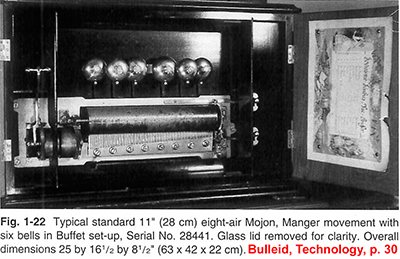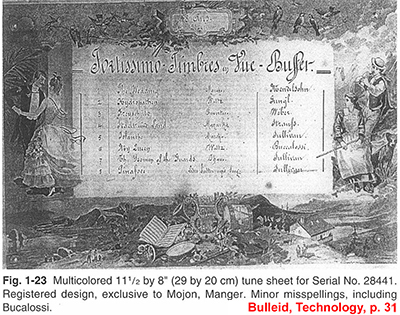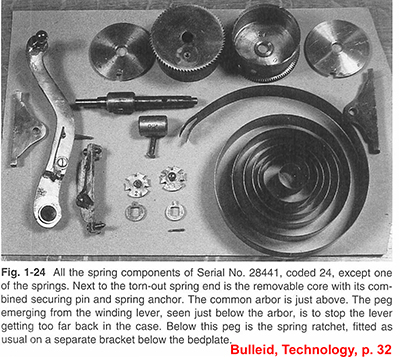
 Spielwerk / Spielwerk /  music box music box
N° 28441
Buffet, N° 28441

The buffet machine schown in Fig. 1-22 is Mojon, Manger Serial No. 28441. It is slightly unusual both for its six bells and for having the tune sheet inscribed „buffet“. Through the French word was in common use for a cupboards it could also mean a small organ, which may have led to its musical box adoption.
The case is of conventional construction, but what would normally be the back and front are furnished respectively with an overhanging top and the usual type of podium. Both are rather casually secured, so if you lift the buffet by the edges of its top it may „come away in your hand“. For this reason folding brass handles are fitted to the sides, which are veneered to the doors. The glass lid is hinged to the winder section partition. The back is covered by a panel 23 ½ by 14“ (60 by 36 cm), lightly secured by panel pins. It hides what looks like the bottom of a conventional case but slightly reduces the radiation efficiency of the shut-in sounding board. The left door is secured by a flush mounted bolt and has a dummy keyhole excutcheon to match the real thing on the right door.

Tune sheet: Tanzpaar-links-Design
Fig. 1-23 shows the tune sheet; with its original wide margings it was fitted sideways on the right door. After repair and slimmig it fitted right way up on the left door and concealed a nasty crack. The latest tune is from The Yeomen of the Guard (1888); the box was probably made in 1890. The only nickel-plated items are the winder, control levers, and a polished metal strip holding the bells. As on other Majon, Manger movements, there are oil-holes in the spring and cylinder bearing brackets and the governor jewel plate, all looking rather silly on their sides.
Serial No. 28411 is stamped on the bass end cylinder bearing bracket. [...] The comb base has a foundry-cast F, presumably Fornachon. Gear ratio, endless to cylinder, is 1820 to 1, about the middle of the contemporary range.
Winding the double spring is by a twin-knobbed lever which may have proved too tempting to some beefy winder because I found both springs torn at their barrel ends, see Fig. 1-24.

It must have taken a very strong arm and a fairly weak brain to break through both sets of Geneva stops and then go on to wreck the springs. Luckily they all seem quite happy after repair.
The first six teeth of the 11“ (28 cm) 78 tooth comb operate the bell strikers, and the design permits easy uncoupling of the bell links. For setting up the mechanism and bells after cleaning it is important to have firm supports for the bedplate. Two 3“ lengths of wood about 1 ½“ square can be fixed with the existing bedplate screws; below the bedplate for general work and above the bedplate for turning upside down to work on the bell mechanism. Final setting of the bell strikers must be done with the mechanism fixes vertically, because their weight falls away from the bells whereas it falls towards them in the normal horizontal mounting of conventional bell boxes. Perhaps for this reason, the strikers here are unadorned to reduce weight and instead colored enamel decorations are addd to the nuts securing the bells.
The musical performance of Serial No. 28411 is very good, and the bells are not over-used. With the well-fitting partitions and glass lid, the sound of the bells is muted, and opening the glass lid brings a remarkable change. So it is surprising that no provision was made, as in hidden bell boxes, for a perforated panel adjoining the glass lid. There was plenty of room for this, as can be seen from Fig. 1-22. So, perhaps, not many buffet boxes with bells were made exactly like Serial No. 28411, though as mentioned above they all tended to be taller than necessary. For example Mojon, Manger Serial No. 29398 and 32649, both with 13“ (33 cm) cylinders, 12 airs, alternate tips, are 14 ½ and 13“ (37 and 33 cm) high respectively; but having no bells they would easily fit in a 10“ (25 cm) high case.
Mojon, Manger bought combs from Karrer. Sometimes they have the makers´s mark on the surface in the form of a curved triangle in a circle with initials AK. (Ord-Hume No. 4)
(S. 31-33)

|


